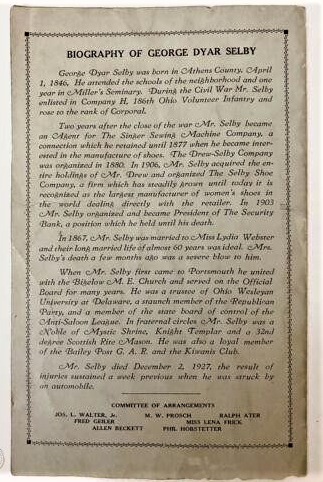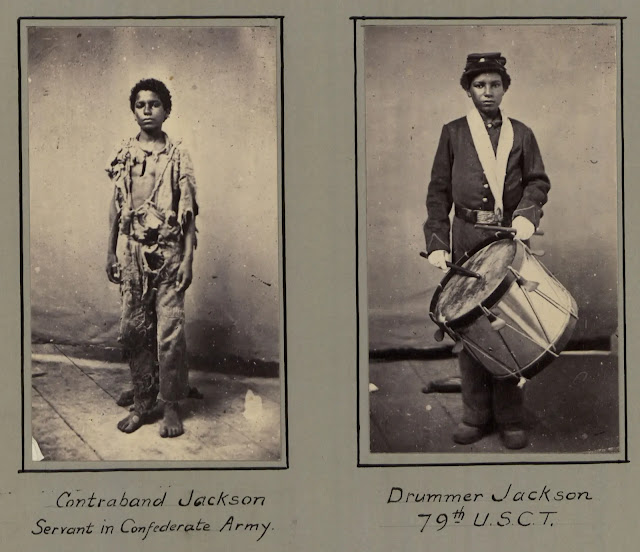Pair of bar shoes, chocolate brown suede with packaging by The Selby Shoe Company, Portsmouth, Ohio, United States of America, c. 1930. 2021. Museum of Applied Arts & Sciences.
As a lover of local history, I found out that George W. Farley (Civil War veteran for whom Farley Square is named) was a houseman – defined as “a man employed for cleaning, maintenance, and other general work” – for Mrs. J. J. Rardin for 25 years.
I assume this is the same wife of Jared Johnson Rardin (born in Athens County, November 30, 1848 and died November 23, 1925) who was a “progressive businessman and representative citizens of Scioto County and who became treasurer of the Selby Shoe Company in Portsmouth, a substantial manufacturing concern of the day.”
(Charles Burleigh Galbreath. History of Ohio, Volume 5. January 1925.)
My mother Emma, along with so many other women in Portsmouth, worked in her younger years for Selby's. This J. J. Rardin reference piqued my interest for exploring some history of the company. Today, I would like to share my findings with you.
Remember, as difficult as it is for many young readers growing up in a poor Appalachian area to accept, Portsmouth was once known as “The Shoe Capital of the World.” Oh, those good old days.
Back in 1950, at what could be argued was the height of the city’s shoe industry, 16% of the Portsmouth work force was in shoes – 1,900 at Selby and 2,000 at Williams.
(“Mitchellace History.” www.zippia.com/.)
Over the years, there have been many shoe factories in Portsmouth. In the 1894 city directory, the following is listed:
• Drew, Selby &
Co., John, 7th and Findlay (streets)
• Excelsior Shoe
Manufacturing Co., 3rd and Gay
• Heer & Kleinknecht, 106-110
Court
• Paden Brothers & Co., 107-111 West Front
•
Russell, Vincent & Williams, 6th and Offnere
• Star Shoe
Co., 39 West Front
In 1901, the manufacturers listed:
• Drew, Selby &
Co., John, Findlay and Gallia (streets)
• Excelsior Shoe
Manufacturing Co., Findlay and Gallia
• Heer Shoe, 350 East
10th
• Portsmouth Shoe Co., 107-109 West Front
• Tremper
Shoe Co., East 6th and Offnere
In 1920, Williams Manufacturing Company was founded and became one of the leading shoe manufacturers of ladies shoes in America. The shoes were priced affordably, especially during the early years prior to the Depression.
The years have brought many shoe factories to Portsmouth (many not mentioned here). Those who may have genealogical ties to Scioto County will probably find an ancestor who worked at one of the many shoe companies
(“The Portsmouth Shoe Industry.” www.yourppl.org/history.)
Photograph shows women working at the William Shoes Company in Portsmouth, Ohio. The women sit facing each other at long wooden workbenches, sewing on Singer sewing machinesKaleb Burchett writes in "Williams Manufacturing Company: Portsmouth, Ohio's Final Shoe Factory" …
“This history starts during the August of 1850, when Robert Bell organized what would come to be known as the Portsmouth Shoe Manufacturing Company. Fast forward to 1877, and Drew Irving and Company is founded that January. The factory would go on to become the famous Selby Shoe Company. A number of other shoe factories (including the focus of this project, Williams, which will be discussed in the next post) also popped up during the era, leading to Portsmouth’s reputation atop the shoe industry.
“Portsmouth has the reputation of turning out the largest number of manufactured shoes of any city of equal population. There are six factories in Portsmouth with a capacity of 20,000 pairs of shoes per day, with a steady output of approximately 15,000 pairs per day. Fully 4,000 people are given employment in the shoe industry alone.
“The amount of leather used in the manufacture of shoes adds further to the industry of the city itself, and it is said that about one million two hundred thousand hides, large and small, are used yearly. The cartons for the shoes are manufactured right in Portsmouth.
“It is said that approximately $10,000 (approximately $251,506 in today’s value) per day is distributed throughout the section covered by Portsmouth by the shoe factory operating there in wages, exclusively of the vast amounts paid out for incidental expenses. The total value of the product of Portsmouth shoe factories is given by its Commercial Association as $7,000,000 (approx. $176,054,242) per year.
“Unfortunately, this success was not sustainable. With the 1976 closure of Williams Manufacturing Company, the town’s shoe industry would basically cease to exist.
“This brings about the question, 'What happened?' Well, that is up for debate. Some argue that the unionization of the industry is what caused the failure. Through studying Williams, it is clear that this is not the case. Instead, the importation of cheaper, foreign shoes made it impossible for local companies to compete. Therefore, regardless of what had happened with unionization, it was inevitable that importation would eventually price these factories into closure.”
(Kaleb Burchett. “Shoe Capital of the World: Portsmouth, OH and the Importance of the Shoe Industry.” Blog entry. https://kalebburchett.wordpress.com/author/knburchett/. March 28, 2018.)
Selby Shoe Company
Bob Boldman of the Portsmouth Daily Times writes that in January of 1877, the Irving Drew & Company was formed. It was reorganized in 1879 under Drew, Selby and Company with partners Irving Drew and George Selby. The first location of their factory was on the third floor of a building on Second Street between Court and Market Streets. Then, in 1881, the plant moved to a leased building at the Northwest corner of Third and Gay Streets. Shoes that were previously made by hand (and foot power) could now be made in this new powered plant.
In 1891, Drew, Selby and Company acquired property at Findlay and John Streets (a city block,) and built their factory at this location. In 1906, Drew was bought out, and the corporate name was changed to Selby Shoe. In 1927, Selby had become the eighth largest maker of shoes in the world with orders being shipped to many other countries of the world, with over 2,000 workers employed at Selby’s.
(Bob Boldman. “Portsmouth -Shoe Capital an Era of Growth.” https://www.portsmouth-dailytimes.com/opinion/columns/34440/portsmouth-shoe-capital-an-era-of-growth. Portsmouth Daily Times. January 18, 2019.)
Selby Shoes began a decline in the 30s and 40s. Selby’s management found their high end lines of women shoes losing market share, and the once thriving company fell victim to a hostile takeover in 1957. While the exodus of Portsmouth's Drew Shoes in 1937, following that year’s devastating flood, marks the start of the industry’s decline, the closure of Selby, in retrospect, now clearly heralded doom for the area shoe workers. Selby’s machines were unbolted and relocated, the former factory used as a warehouse before its demolition in the early 1990s.
(Andrew Lee Feight, Ph.D., “Sole Choice & the Portsmouth Shoe Industry,” Scioto Historical, accessed January 31, 2022, https://sciotohistorical.org/items/show/44.)
3 photos 1927 Selby Shoe Co President George Selby Memorial Program Portsmouth Ohio
George Selby
The Lancaster Daily
Eagle reported December 2, 1927, that George
D. Selby, 81, Portsmouth shoe manufacturer and prominent banker –
injured when his automobile skidded off the road near here last week
– died in the Sheleterting Arms Hospital, here.
Death,
according to physicians who attended, was caused by injuries and
bronchial pneumonia.
The article in The
Eagle declared …
“Women of the nation
walked a fortune right into the pockets of Mr. Selby who made
millions in women's shoes headed what is said to be the world's
largest plant manufacturing shoes for women, the Selby Shoe Company
of Portsmouth, Ohio.
“He is accredited with originating the
idea of selling shoes directly to the trade.
“In his early
days Selby traveled by horse and buggy displaying the wonders of the
first sewing machines. He became an agent for the Singer Sewing
Machine Company two years after the close of the Civil War and
remained with the company until 1880 when he turned to the shoe
manufacturing business and organized the Drew-Selby Company with
Irving Drew and Bernard Damon at Portsmouth.
“Irving and
Damon previously operated a hand-made shoe company but the new
company was a machine plant with a capacity of 100 pairs of women's
shoes a day. The first year the company did a $70,000 business.
“Geo. Selby was an
ardent prohibitionist and was known throughout Portsmotuh and
vicinity for his generous benefactions. He was a member of the
Methodist Church and a 32nd degree Mason., a member of the Ancient
Arabic Ordez Nobles of the Mystic Shrine and a Knight Templar.
“In
addition to his shoe factory at Portsmouth he operated and owned
factories at Ironton and Ashland, Ohio.”
(AP. “Wealthy Shoe Manufacturer Dies: Had World's Largest Plant for Manufacturing Shoes for Women.” The Lancaster Daily Eagle. December 2, 1927.)
Historical Note:
The Selby 100 Mile House is an elegant, colonial style, mansion set on over 11 acres along the beautiful Ohio River. The 37-room mansion is located just one hundred miles from Cincinnati, Ohio and one hundred miles from Point Pleasant, West Virginia and is just outside Portsmouth, Ohio. The stone and brick structure was originally constructed, in 1927, as a residence for the prominent, Portsmouth businessman, Charles D Scudder.
The mansion was purchased in 1937 by businessman Roger Selby, president of the Selby Shoe Company, of Portsmouth, Ohio. Roger Selby was not only a distinguished entrepreneur but also a world-renowned breeder of Arabian horses. History states Roger Selby had numerous communications and purchased multiple champion Arabian horses from Lady Wentworth, the famous British royal and owner of Crabbet Arabian Stud Farm. The Selby 100 Mile House & Gardens retained the most famous Arabian Stallion worldwide, during this period, known as “Mirage.”
This is an original 1928 black and white print ad promoting the Arch Preserver Shoes from Selby Shoe Company located at 710 7th Street, Portsmouth, Ohio. Ohio Guide Photographs. Ohio History Connection.
Henry A. Lorberg , “E. J. Corson; Louis Stetzinger; J. J. Rardin; C. H. Harris; Portsmouth Business Ads ,” Local History Digital Collection/ https://www.yourppl.org/history/items/show/21298.
|
|
|
Dark brown leather ladies lace-up boots made by Selby Shoe Company in Portsmouth, Ohio. These boots appear to be about size 6-7. The Selby Shoe Company was first listed in the 1906 Portsmouth City Directory located at John and Seventh (7th) Streets. George D. Selby (1846-1927) was president, Pearl E. Selby (1870-1958) and Sanford P. Selby (1853-1931) were vice-presidents, Mark W. Selby (1880-1959) was secretary, and J.J. Rardin was treasurer. George D. and Lydia Selby listed their residence at 145 Gallia Street.































